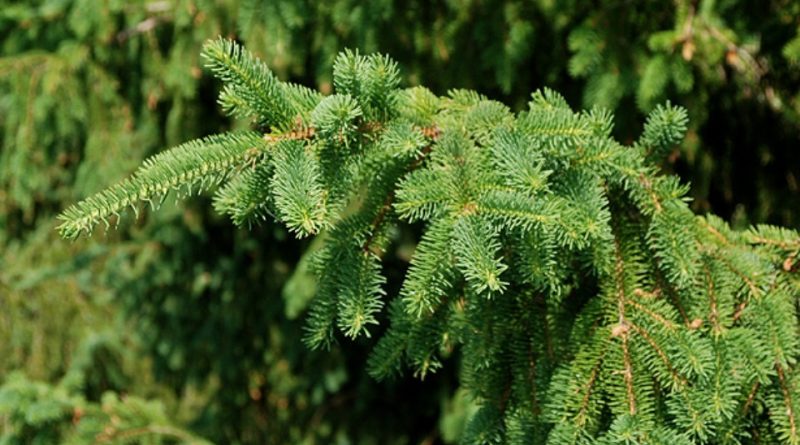Picea koyamae
Picea koyamae
The Koyama’s Spruce (Picea koyamae Shiras., 1913) is an arboreal species belonging to the Pinaceae family.
Systematics –
From a systematic point of view it belongs to:
Eukaryota domain,
Kingdom Plantae,
Pinophyta division,
Class Pinopsida,
Pinales Order,
Pinaceae family,
Genus Picea,
P. koyamae species.
Etymology –
The term Picea, already used by the Latins, could, according to an etymological interpretation, derive from Pix picis = pitch, in reference to the abundant production of resin.
The specific epithet koyamae was given in honor of the Japanese botanist Mitsua Koyama, who was the first to discover the species in 1911.
Geographic Distribution and Habitat –
Picea koyamae is a rare conifer native to the Akaishi Mountains and Yatsugatake Mountains, Nagano and Yamanashi Prefectures, in the central part of the island of Honshū, Japan.
Its natural habitat is between 1100 and 2000 m of altitude, on volcanic soils in the Yatsugatake mountains, while in the Akaishi mountains it is also found on phylladic, calcareous or sandy soils. It is found in small groups of trees in mixed forests with Larix kaempferi, Thuja standishii, Picea maximowiczii, Pinus koraiensis and Quercus mongolica var. grosserrata.
Description –
Picea koyamae is a conifer that grows up to 25 meters with a single straight trunk that can reach 60 cm in diameter. The crown is pyramidal or conical, open and more irregular in older specimens and the branches of the first order are long and slender, horizontally developed or ascending. Those of the second order are dense and hanging. The shoots are slender, solid, initially pale yellowish-brown, then darker orange-brown, grooved and wrinkled, glabrous or locally pubescent; the pulvini are well developed, 1-1,5 mm long.
The bark is brown in color and peels off when young; over the years it then becomes grey-brown or grey-blackish, becoming wrinkled.
The leaves are needle-like, rigid, linear, curved, dark green above, bluish-green below, 0,8-1,5 cm long, rhombic section, with acute tips; they have stomata arranged in 3-5 lines on all four faces. The vegetative buds are ovoid-conical, 4-13 mm long, very resinous; they have triangular-ovate pearls, light brown or red-brown in color, which persist for years.
The male cones are yellowish, carried in the axillary position, in clusters, 1-1.5 cm long.
The female cones are sessile, ovoid-oblong or cylindrical, initially erect, then hanging when ripe, with obtuse tips, 4-9 cm long and 3-3,5 cm broad, initially green-purple or green, then dark brown. The macrosporophylls are obovate-suborbicular, slightly convex and often resinous, with a smooth, finely striated and glabrous abaxial surface, 0.6-1.8 cm long. The bracts are rudimentary, ligulate, 2-3 mm long, totally included. The dark brown seeds are ovoid-conical and 2-4 mm long, with an oblong-ovate winged part, 5-10 mm long, of a pale yellowish-brown colour.
Cultivation –
Picea koyamae is an evergreen tree that grows in small isolated stands in a limited area, and the total occupation area is less than 100 square kilometers. Trees that are lost to typhoons are normally replaced with other, faster growing species, and the International Union for Conservation of Nature has classified the tree as “critically endangered”. Some trees are in cultivation as an ornamental tree.
The plant normally reproduces by seed.
Customs and Traditions –
Picea koyamae is a conifer that was discovered in 1911, and later, a second sub-population in 1960, for an estimated total of less than a thousand adult specimens.
This plant is known in Japanese as: ヤツガタケトウヒ or やつがたけとうひ yatsugatake-touhi) and is a rare conifer from Japan.
Given its rarity, it is of no economic importance. Unsuitable for reforestation due to its slow growth, it has been successfully introduced in the botanical gardens of Northern Europe and North America.
Regarding its state of conservation. with an estimated primary range of less than 100 km², moreover jagged, and a decreasing population of adult individuals that does not exceed 1000 units, the species is highly exposed to the risks deriving from climate change and the relative modification of the habitat; for which, as said, it is therefore classified as critically endangered species in the IUCN Red List.
Method of Preparation –
The Picea koyamae, also due to its rarity, is of no interest either from a food point of view or for the use of timber.
It may fulfill some role as an ornamental plant in similar habitats or as a species for botanic gardens.
Guido Bissanti
Sources
– Acta Plantarum – Flora of the Italian Regions.
– Wikipedia, the free encyclopedia.
– GBIF, the Global Biodiversity Information Facility.
– Useful Tropical Plants Database.
– Conti F., Abbate G., Alessandrini A., Blasi C. (ed.), 2005. An annotated checklist of the Italian vascular flora, Palombi Editore.
– Pignatti S., 1982. Flora of Italy, Edagricole, Bologna.
– Treben M., 2000. Health from the Lord’s Pharmacy, Advice and experiences with medicinal herbs, Ennsthaler Editore.
Photo source:
– https://landscapeplants.oregonstate.edu/plants/picea-koyamae
– https://medialib.naturalis.nl/file/id/WAG.1360216/format/large
Attention: The pharmaceutical applications and alimurgical uses are indicated for informational purposes only, they do not in any way represent a medical prescription; we therefore decline all responsibility for their use for curative, aesthetic or food purposes.


